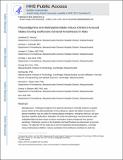| dc.contributor.author | Kenny, Jonathan D. | |
| dc.contributor.author | Chemali, Jessica J. | |
| dc.contributor.author | Cotten, Joseph F. | |
| dc.contributor.author | Van Dort, Christa J. | |
| dc.contributor.author | Taylor, Norman E. | |
| dc.contributor.author | Brown, Emery Neal | |
| dc.contributor.author | Solt, Ken | |
| dc.contributor.author | Kim, Seong-Eun | |
| dc.contributor.author | Ba, Demba E | |
| dc.date.accessioned | 2017-12-08T15:35:54Z | |
| dc.date.available | 2017-12-08T15:35:54Z | |
| dc.date.issued | 2016-11 | |
| dc.identifier.issn | 0003-2999 | |
| dc.identifier.uri | http://hdl.handle.net/1721.1/112652 | |
| dc.description.abstract | BACKGROUND: Although emergence from general anesthesia is clinically treated as a passive process driven by the pharmacokinetics of drug clearance, agents that hasten recovery from general anesthesia may be useful for treating delayed emergence, emergence delirium, and postoperative cognitive dysfunction. Activation of central monoaminergic neurotransmission with methylphenidate has been shown to induce reanimation (active emergence) from general anesthesia. Cholinergic neurons in the brainstem and basal forebrain are also known to promote arousal. The objective of this study was to test the hypothesis that physostigmine, a centrally acting cholinesterase inhibitor, induces reanimation from isoflurane anesthesia in adult rats. METHODS: The dose-dependent effects of physostigmine on time to emergence from a standardized isoflurane general anesthetic were tested. It was then determined whether physostigmine restores righting during continuous isoflurane anesthesia. In a separate group of rats with implanted extradural electrodes, physostigmine was administered during continuous inhalation of 1.0% isoflurane, and the electroencephalogram changes were recorded. Finally, 2.0% isoflurane was used to induce burst suppression, and the effects of physostigmine and methylphenidate on burst suppression probability (BSP) were tested. RESULTS: Physostigmine delayed time to emergence from isoflurane anesthesia at doses ≥0.2 mg/kg (n = 9). During continuous isoflurane anesthesia (0.9% ± 0.1%), physostigmine did not restore righting (n = 9). Blocking the peripheral side effects of physostigmine with the coadministration of glycopyrrolate (a muscarinic antagonist that does not cross the blood-brain barrier) produced similar results (n = 9 each). However, during inhalation of 1.0% isoflurane, physostigmine shifted peak electroencephalogram power from δ ( < 4 Hz) to θ (4-8 Hz) in 6 of 6 rats. During continuous 2.0% isoflurane anesthesia, physostigmine induced large, statistically significant decreases in BSP in 6 of 6 rats, whereas methylphenidate did not. CONCLUSIONS: Unlike methylphenidate, physostigmine does not accelerate time to emergence from isoflurane anesthesia and does not restore righting during continuous isoflurane anesthesia. However, physostigmine consistently decreases BSP during deep isoflurane anesthesia, whereas methylphenidate does not. These findings suggest that activation of cholinergic neurotransmission during isoflurane anesthesia produces arousal states that are distinct from those induced by monoaminergic activation. | en_US |
| dc.description.sponsorship | National Institutes of Health (U.S.) (Grant TR01-GM104948) | en_US |
| dc.description.sponsorship | National Institutes of Health (U.S.) (Grant DP1-OD003646) | en_US |
| dc.description.sponsorship | National Institutes of Health (U.S.) (Grant K08-GM094394) | en_US |
| dc.publisher | Ovid Technologies (Wolters Kluwer Health) | en_US |
| dc.relation.isversionof | http://dx.doi.org/10.1213/ANE.0000000000001234 | en_US |
| dc.rights | Creative Commons Attribution-Noncommercial-Share Alike | en_US |
| dc.rights.uri | http://creativecommons.org/licenses/by-nc-sa/4.0/ | en_US |
| dc.source | PMC | en_US |
| dc.title | Physostigmine and Methylphenidate Induce Distinct Arousal States During Isoflurane General Anesthesia in Rats | en_US |
| dc.type | Article | en_US |
| dc.identifier.citation | Kenny, Jonathan D. et al. “Physostigmine and Methylphenidate Induce Distinct Arousal States During Isoflurane General Anesthesia in Rats.” Anesthesia & Analgesia 123, 5 (November 2016): 1210–1219 © 2016 International Anesthesia Research Society | en_US |
| dc.contributor.department | Massachusetts Institute of Technology. Department of Brain and Cognitive Sciences | en_US |
| dc.contributor.department | Picower Institute for Learning and Memory | en_US |
| dc.contributor.mitauthor | Kim, Seong-Eun | |
| dc.contributor.mitauthor | Ba, Demba E | |
| dc.relation.journal | Anesthesia & Analgesia | en_US |
| dc.eprint.version | Author's final manuscript | en_US |
| dc.type.uri | http://purl.org/eprint/type/JournalArticle | en_US |
| eprint.status | http://purl.org/eprint/status/PeerReviewed | en_US |
| dc.date.updated | 2017-12-07T19:28:27Z | |
| dspace.orderedauthors | Kenny, Jonathan D.; Chemali, Jessica J.; Cotten, Joseph F.; Van Dort, Christa J.; Kim, Seong-Eun; Ba, Demba; Taylor, Norman E.; Brown, Emery N.; Solt, Ken | en_US |
| dspace.embargo.terms | N | en_US |
| dc.identifier.orcid | https://orcid.org/0000-0002-4518-4208 | |
| mit.license | OPEN_ACCESS_POLICY | en_US |
| mit.metadata.status | Complete | |
